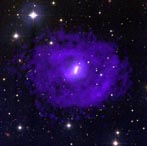Dwarf galaxy in nearby universe possibly 10-bln-year older than previously thought

Paris, Oct 17 : The NASA/ESA Hubble Space Telescope has found out the true nature of a dwarf galaxy that astronomers had for a long time identified as one of the youngest galaxies in the Universe.
Observation of the galaxy I Zwicky 18 indicates that it is in fact much older and much farther away than previously thought.
Earlier observations of the galaxy at the Palomar Observatory around 40 years ago seemed to show that it was one of the youngest galaxies in the nearby Universe.
Studies then suggested that the galaxy had erupted with star formation billions of years after its galactic neighbours, like our galaxy the Milky Way.
But new findings by the Hubble Space Telescope have quashed these theories.
The telescope found fainter older red stars contained within the galaxy, suggesting its star formation started at least one billion years ago and possibly as much as 10 billion years ago.
Astronomers now believe, the galaxy formed at the same time as most other galaxies.
“Although the galaxy is not as youthful as was once believed, it is certainly developmentally challenged and unique in the nearby Universe,” said lead author astronomer Alessandra Aloisi from the European Space Agency/Space Telescope Science Institute.
Aloisi said, spectroscopic observations with ground-based telescopes has also shown that I Zwicky 18 is mostly composed of hydrogen and helium, the main ingredients created in the Big Bang.
She said it means that the stars within it did not create the same amounts of heavier elements as seen in other galaxies nearby.
She said the galaxy's primordial makeup suggests that its rate of star formation has been much lower than that of other galaxies of similar age.
Nevertheless, it remains an outstanding mystery why I Zwicky 18 formed so few stars in the past, and why it is forming so many new stars right now, she said, adding that the new Hubble data has suggested that I Zwicky 18 is 59 million light-years from Earth, almost 10 million light-years more distant than previously believed.
She said the galaxy's larger-than-expected distance could possibly explain why astronomers had difficulty detecting older, fainter stars within the galaxy until now.
“In fact, the faint old stars in I Zwicky 18 are almost at the limit of Hubble's sensitivity and resolution,” she said.
Aloisi and her team have published their results in the Oct. 1 issue of the Astrophysical Journal Letters. (ANI)